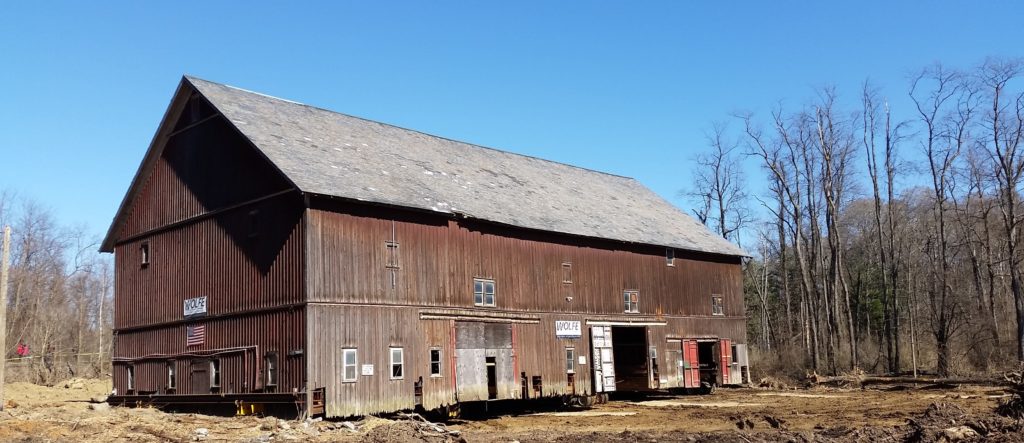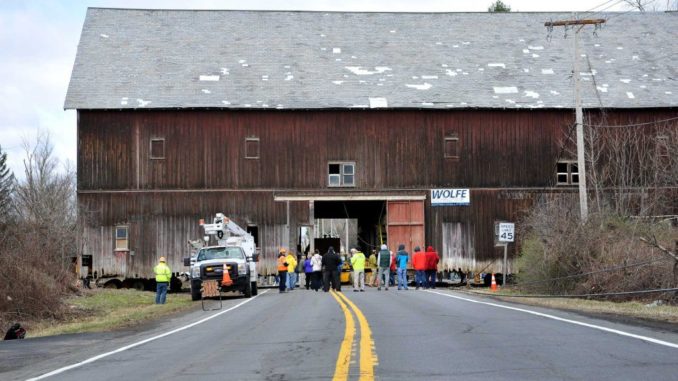
March 29th, 2016 was a historic day for our small Town of New Scotland. It started out like any other; politicians put on their suits and adjusted their ties, reporters grabbed their recorders and made sure their blazers looked prime, villagers in Voorheesville ate their cereal and finished the Altamont Enterprise, and construction workers woke at dawn to set up at their site. However, instead of driving to their typical work day destinations, these groups of people headed down to the remnants of the previous LeVie Farm to watch the mighty Hilton Barn begin a new life.
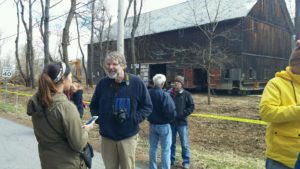
As the sun rose higher in the day, the amassing crowd of spectators grew. Police blocked off Route 85A from both directions, reporters lined up to interview Mohawk Hudson Land Conservancy (MHLC) Executive Director Mark King, Town Historian Robert Parmenter welcomed onlookers, Dylon Longton made sure his drone and cameras captured the scene, and New Scotland Town Board members and Village of Voorheesville leaders gathered to participate in the significance of the day. For those who went to school and complied with their work commitments, they watched time lapse videos on Facebook, read interviews online, and drove by the site on their way home. But those present watched in awe as the crew, through 40mph winds, guided the structure over the road, rotated this 60-foot wide, 120-foot long, and 60-foot tall barn and helped make its slow and steady move to its new home.
With the typical nature of such events, photographs were taken, questions were posed to critical organizers of the move, and articles were written. Science folks examined the mechanics of the one man, his remote, and his control over the entire operation, and all reflected on the memorability of the day and its future purpose in our town. However, what many failed to comprehend is the historical significance of the barn itself and the immense difficulties overcome to secure the structure.
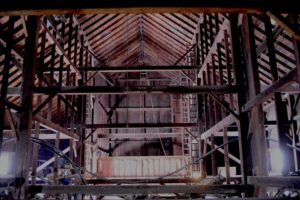 The Hilton Barn was constructed in 1898 by a man named Frank Osterhout. While his name may be unfamiliar to the average Voorheesvillian, this man established the Furman Barn, located at the corner of Krumkill Road and Font Grove, and the Waldbillig Barn, built on the former Gerard Farm where the Vly Creek meets the Normanskill. His construction on the LeVie Farm is the largest timber-frame structure in Albany County and originally served as the storage for the “Hilton family’s prize-winning Devonshire cattle and massive amounts of hay.” Such a detail is imperative to our understanding of the barn’s significance. Representing a time in our history when agriculture served as a major source of income for our town, the barn stored the hay that fed the horses that supplied the transportation needs of many New Scotlanders.
The Hilton Barn was constructed in 1898 by a man named Frank Osterhout. While his name may be unfamiliar to the average Voorheesvillian, this man established the Furman Barn, located at the corner of Krumkill Road and Font Grove, and the Waldbillig Barn, built on the former Gerard Farm where the Vly Creek meets the Normanskill. His construction on the LeVie Farm is the largest timber-frame structure in Albany County and originally served as the storage for the “Hilton family’s prize-winning Devonshire cattle and massive amounts of hay.” Such a detail is imperative to our understanding of the barn’s significance. Representing a time in our history when agriculture served as a major source of income for our town, the barn stored the hay that fed the horses that supplied the transportation needs of many New Scotlanders.
Unfortunately, in 1914 the barn was severely damaged by a fire and had to be rebuilt. Because of its significance, however, over 160 townsmen voluntarily came together with tools and timber to restore the barn to its former glory. This act was no small feat, and resulted in an even greater sense of pride and community connection to this building.
Due to the unique stature of this landmark, when Country Club Partner owners announced in 2014 that the barn would be demolished to accommodate new housing, there was great public concern. The owners cited a lack of sufficient uses and no interested buyers, and failed to offer an alternative for the future of the barn. They immediately set a deadline of February 28th, 2015 for relocation proposals, determining that deconstruction would begin May 31st if plans were not sufficiently carried through. As the deadlines neared, financial support for either reconstruction or relocation, and potential locations for the barn’s future home were not yet clear.
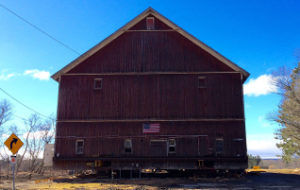 More than a year ago, the Town of New Scotland approached the Mohawk Hudson Land Conservancy for assistance in saving this barn. The MHLC was further able to contact the heirs of the Hilton family who coincidentally owned the property across Route 85A from the site of the barn. The heirs are two siblings, Jennifer and George, who originally welcomed the idea of relocating the Hilton Barn onto their property. However, as time wore on, support from one of the siblings waned. Mark King remarked, “What started as a great prospect of a donation of land turned into a struggle to purchase slightly more than an acre. Weeks of negotiations turned into months and as demolition deadlines came and went, the [Mohawk Hudson Land] Conservancy and those supporting the move of the barn sometimes felt like success would not be possible.” The project seemed to be at an all-time low with a lack of cooperation, loss of faith, and pressing deadline of demolition if the plans were not carried through. Email chains included phrases such as, “We are simply out of time.” and “Looks dead to me.” and “If we don’t have anything in the next 24 hours, we are contractually obligated to start the dismantling.”
More than a year ago, the Town of New Scotland approached the Mohawk Hudson Land Conservancy for assistance in saving this barn. The MHLC was further able to contact the heirs of the Hilton family who coincidentally owned the property across Route 85A from the site of the barn. The heirs are two siblings, Jennifer and George, who originally welcomed the idea of relocating the Hilton Barn onto their property. However, as time wore on, support from one of the siblings waned. Mark King remarked, “What started as a great prospect of a donation of land turned into a struggle to purchase slightly more than an acre. Weeks of negotiations turned into months and as demolition deadlines came and went, the [Mohawk Hudson Land] Conservancy and those supporting the move of the barn sometimes felt like success would not be possible.” The project seemed to be at an all-time low with a lack of cooperation, loss of faith, and pressing deadline of demolition if the plans were not carried through. Email chains included phrases such as, “We are simply out of time.” and “Looks dead to me.” and “If we don’t have anything in the next 24 hours, we are contractually obligated to start the dismantling.”
Fortunately, with the election of a new Town Board at the start of 2016, new energy was added to the movement. MHLC worked closely with the Board to beg for more time, hire engineers, gather grants, and convince the George that saving the barn was an imperative step in preserving our town’s history. In the end, the move was financed by a $50,000 grant from Albany County, the generosity of MHLC donors, and a $125,000 grant secured by Assembly Member Patricia Fahy.
Yet, the complex nature of the barn’s relocation did not stop with the securing of funds. Construction plans required weeks of preparation for the move. Time was spent digging beneath the barn to secure the support beams, raising the structure onto wheels, and bringing it up to the edge of the road to ensure success for the big day. Now that the barn has been relocated, the Town will lay the cement foundation, and finally lower the barn down onto its final perch.
For now, the town can breathe easy and dream up the Hilton Barn’s potential future purpose as, “a farmers market, a bike rental store, an interpretive history museum, a restaurant…” or an enhancement to the Rail Trail. While we may not have been around for the construction in 1898 or the rebuilding of the barn in 1914, today, more than 100 years later, we can celebrate its prominence in our history, and enjoy the value it adds to the modern features of our Town.

